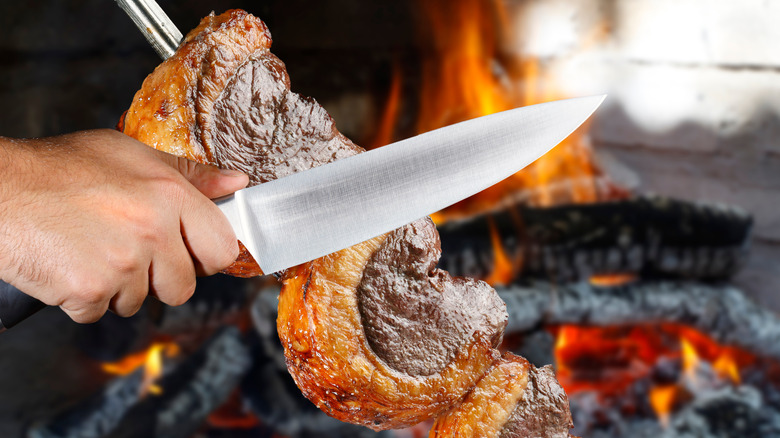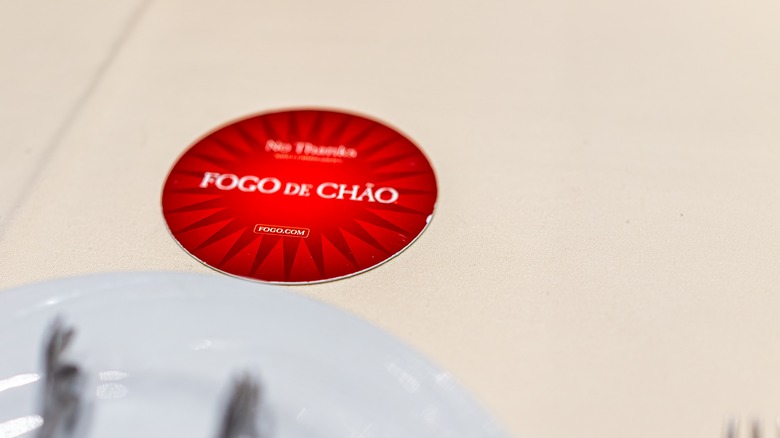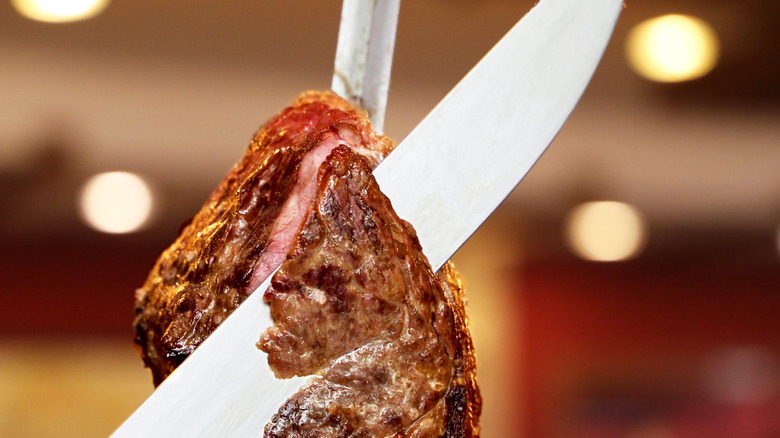How To Quietly Signal For More Meat At Brazilian Barbecues
The U.S. is certainly unfamiliar with a good steakhouse, besides common chains like Outback Steakhouse, and Texas Roadhouse, there are the more "high-end" offerings like Ruth's Chris Steakhouse out there as well. Some experts know all the steakhouse secrets, but even they might be caught off guard when going to a Brazilian barbecue.
A Brazilian steakhouse, or Churrascaria, is exactly what you think of when you hear "steakhouse" in many ways – the smell of roasted meat in the air, waiters carrying different cuts around to hungry diners, etc. These unique steakhouses can be found all over the U.S. They have their own unique dining style that takes some getting used to, however.
Most churrascarias are all-you-can-eat affairs. While there is usually a salad bar with some appetizers, the main stars of the show are the meats roasted on skewers that the waiters (referred to as gauchos) carry from table to table. It's up to you whether or not you take one cur or the other, but besides that, the waiters will continue to bring out different cuts of meat. Unless you use the quiet signal that you've had enough that is.
How to control the pace
As The New York Daily News points out, visiting a churrascaria isn't a sprint, it's a marathon. If you really want to get the most out of your money at a Brazilian steakhouse without exploding you'll need to pace yourself.
Thankfully, these restaurants provide a helpful tool to manage this pace. 12 Cuts Steakhouse notes that most churrascarias will give a sign, cube, or totem with a red side and a green side. The symbolism here is pretty simple, green means go, and red means stop. That means you can start your meal with a trip to the salad bar, and once you're ready simply flip your sign to let the gauchos know you're ready for the meat. The New York Daily News claims that the earliest cuts they bring out at this point will tend to be the lower-value meats, so it can pay to skip the first few rounds unless you know what you're getting.
This signal can also be used to spare yourself from being overloaded with meat. The gauchos can bring out each of their different cuts fairly quickly, and before you know it your plate will be loaded up with assorted meats. We're not saying this is a bad thing for a devoted carnivore, but it can be a little overwhelming for some. Feel free to flip your signal back to red anytime you need to take a breather.
History of the churrascaria
The concept of a churrascaria may sound like an invention of modern indulgences, but its roots actually go back centuries. Anyone who recognized the term 'gaucho' might be able to guess that this practice of barbecuing dates back to the practices of South American cattle ranchers. Boi Na Braza claims that it was these nomadic cowboys that first invented the Churrasco style of cooking in the 1800s.
The Manual says that this style of cuisine includes slow cooking to lock in the meat's juices, and seasoning simply with salt to enhance the natural flavors that are present. Once Brazil became more urbanized in the 1940s, the gauchos brought their cooking traditions with them into the cities, and this style of cooking spread quickly.
Now, it is hard to find a home in Brazil that doesn't have a modern Churrasco-style grill installed in its backyard. This practice was originally devised as a communal meal where everyone gathered together for a hearty meal. This cooking style still seems to hold that place in the heart of Brazilians today.


